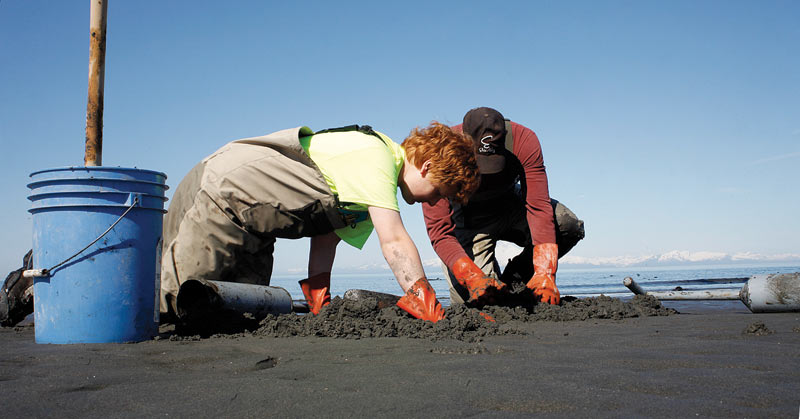When people on the shore of Cook Inlet talk about “razors” they may be referring to Schick or Gillette, or they might be talking about the plentiful population of Pacific razor clams found in the coastline’s muddy tide plain.
This sort of razor can be found in clusters up and down the west coast of North America — in Oregon and Washington, British Columbia, and of course on the Kenai
Peninsula, which supports Alaska’s largest sport and personal use razor clam fishery. Their presence gives rise to the popular and accessible past-time of clamming.
Gathering these tasty clams requires a sport fishing license, a clam shovel, waterproof boots, a bucket, and a willingness to get covered in mud.
After gathering your supplies, check a tide book for the next minus tide, and head to the beaches of Clam Gulch.
Located 20 miles south of Soldotna on the Sterling Highway, the town of Clam Gulch is home to Clam Gulch State Recreation Area. Prospective clammers can take advantage of the recreation area’s day-use parking, overnight camping, and access road that allows four-wheel drive or all-terrain vehicles on to the beach. For more information on camping at Clam Gulch, see our park guide.
Two-wheel drive vehicles should never be taken onto any Alaskan beach, and all vehicles should stay well above the tide line.
While clams can be legally harvested throughout the year, the prime season is April through September. Clams dug during their July and August spawning period are plumper — and considered to be weaker-tasting — than early summer clams. A tide of minus 2.0 or less provides the best access to clam beds. Razor clams can be found beneath the dimples they leave in the surface of the sand, created by the withdrawal of the clam’s neck. Digging three to six inches below the dimple will reveal the clam. Quick digging is crucial, since the clam will use its foot to pull itself deeper into the sand. Before grabbing the clam from the mud, remember their shells can be sharp.
If a clam’s shell is broken during digging, its meat will still be tasty. Alaska’s Department of Fish and Game, requires diggers to retain all razor clams.

